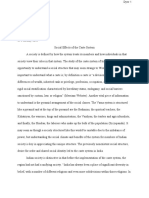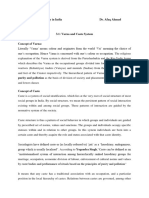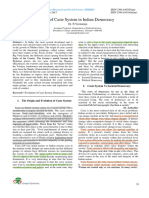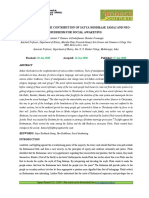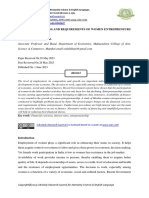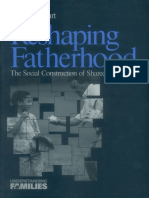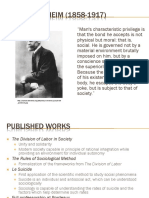Satnami Samaj: Challenging Rural Caste Institution in Chhattisgarh
Satnami Samaj: Challenging Rural Caste Institution in Chhattisgarh
Uploaded by
Anonymous CwJeBCAXpCopyright:
Available Formats
Satnami Samaj: Challenging Rural Caste Institution in Chhattisgarh
Satnami Samaj: Challenging Rural Caste Institution in Chhattisgarh
Uploaded by
Anonymous CwJeBCAXpOriginal Title
Copyright
Available Formats
Share this document
Did you find this document useful?
Is this content inappropriate?
Copyright:
Available Formats
Satnami Samaj: Challenging Rural Caste Institution in Chhattisgarh
Satnami Samaj: Challenging Rural Caste Institution in Chhattisgarh
Uploaded by
Anonymous CwJeBCAXpCopyright:
Available Formats
Scholarly Research Journal for Interdisciplinary Studies,
Online ISSN 2278-8808, SJIF 2016 = 6.17, www.srjis.com
UGC Approved Sr. No.45269, SEPT-OCT 2017, VOL- 4/36
10.21922/srjis.v4i36.10010
SATNAMI SAMAJ: CHALLENGING RURAL CASTE INSTITUTION IN
CHHATTISGARH
Sanjiw Kumar Manjre
PhD Research Scholar, Centre for Studies and Research in Society and Development
Central University of Gujarat, Gandhinagar
SatnamiSamaj is almost living in rural Chhattisgarh (India). It has separate social institutions from
Hinduism. Satnamis have own Bhandari and Satidar (ritual priest) who are conducting the entire
social functions such as marriages, death ceremonies, religious rituals and nomination of a new born
baby in the society. All these changes were really challenging for the Satnamisamaj which comes
after long social and religious Satnami movement. Its credit goes to Guru Ghasidas and his followers
during the early 19th Century. Satnamisamaj had been rejected to caste hierarchy. Though, change is
a continuous process hence rural caste institutions have been changing. Books, articles, internet and
others useful secondary resources have been used to complete the research paper.
Keywords: SatnamiSamaj, Rural, Caste Institution, Chhattisgarh
Scholarly Research Journal's is licensed Based on a work at www.srjis.com
Introduction: Any rural society is living in Indian villages. Earlier, rural India represents a
few numbers of people who were lived together in natural setting and practices together for
food arrangement and against of outsider forces. Agriculture was the main occupation of the
rural society in Chhattisgarh, India. But, nowadays rural society is going to change rapidly
maybe there are so many factors. Hence, we can take two major factors like natural factors
(migration, famine etc.) and social factors. These two factors cover all the causes of change
of social institutions in India. But, here we will discuss caste institution (a social factor) in
Chhattisgarh, India. Where Satnami is a caste but doesn't consider casteism and rejected the
Brahmanism, superiority caste institutions.
In Chhattisgarh, Satnamisamaj comes under the Scheduled Castes from the point of
constitutional classification. The Satnami is estimated to be 70-80 percent of the Scheduled
Castes population and it is 12 percent of the whole population of Chhattisgarh. However,
caste discrimination cannot be denied on seeing the previous caste-wise census. Due to being
Copyright 2017, Scholarly Research Journal for Interdisciplinary Studies
Sanjiw Kumar Manjre
6653
(Pg. 6652-6656)
from the Scheduled Castes category, they face the difficulties and inhuman of Hindu social
institution like caste and religion.
Indian caste society has been most dangerous and unique social institution around the
world. Dangerous in the sense, caste is a very complex system, hierarchy, nation of pure and
impure, cruelty never can leave once you got by birth, and you have to suffer whole life
within caste identity. You have to insult any part of the country; sometimes you have to lose
his/her life or dignity and so on. All are these losses because of the only caste. So, in 21st
Century we have to think seriously, otherwise, we can't even imagine what consequences will
have to suffer.
Satnami Samaj: In Chhattisgarh, Satnamisamaj has come into existence in early 19th
Century. Guru Ghasidas was a founder of Satnamisamaj. Satnamis are followers of the
Satnam' and called themselves Satnami. Guru Ghasidas regards his ideal, therefore, Satnami
tries to follow his teaching and walk on the path of truth. Satnamisamaj never believes on the
caste system. Instead of this, they accept to assimilate messages of Guru as
"MankheMankheEkSamanAay".
Satnamisamaj is also known for some prohibition on food like meat; liquor also
prohibited some vegetable chili, tomato, lentils, brinjal etc. Satnamisamaj had been rejected
these kinds of food practices becausethe founder of the Satnami community had been teach
earlier and take oath from the side of follower of Satnam. That time higher castes people
were practicesuntouchability with lower castes along with the Satnami. Theywere
considereduntouchables because from Shudra Varnaseveral castes joined themselves and
become Satnami. But, most of the time whowere practicinguntouchability in rural India even
they belong to an untouchable (Shudra Varna). But, in truth, it was also a politics with
downtrodden people. Satnamisamaj is understood that divide politics therefore, they don't
discriminate with other castes because Guru Ghasidas taught them about humanity almost
150 years ago.
What is a Caste Institution? It is a part of the social institution like family and religion. But,
caste is an unequal and unique institution which determines and maintains hierarchy. Some
caste always determines superior and pure another side largely castes are determines lower
and filthy. In actual, the caste system is a caste institution. That follows certain rigid tradition
as the caste system;its called a caste institution.
How works Caste Institution: This point is very interesting because of its system unique in
the world. Therefore, here we will focus and discuss on Indian caste institution.
Copyright 2017, Scholarly Research Journal for Interdisciplinary Studies
Sanjiw Kumar Manjre
6654
(Pg. 6652-6656)
Caste institution works on based on the Varna Vyavastha(four hierarchal steps).
Namely, Brahman, Kshatriya, Vaishyas, and Shudra, according to this Vyavastha from left to
right three (Brahman, Kshatriya, and Vaishyas) Varna have power and rights in different
sections but Shudra excluded forever for everything. Shudra doesn't have rights to the
property, education, religious chant, good clothes, and sandals etc. but they will do cleaning
works always without question. Brahman was superior of this Vyavastha.
Ascribed and Achieved this two sociological and anthropological terms, explain
the Varna Vyavastha that how one person can be by birth superior and achieving other thing
have to do hard work. Here, my point is that, if the person wants to be a success, and they
dont have the rights to move forward work hard and keep the property then he is forced to do
the works badly like an animal, then how can one improve? For instance, a student becomes
an engineer by working hard then it is his achieved status because he did hard work for gain
the position another side ascribed status gives birth from fathers side it means, father the
Shudra then the child will be the Shudra if father the Brahman then the child will be the
Brahman. Here, no matter for knowledge, character or lazy.
In Indian society, the occupation also used to determine the pure-impure among the
people. This was the stigma for human society that was later transformed into castes. To
which we see people still working according to their caste in our daily life. This shows that
the caste is a dangerous disease that divides the entire human society into a mentally pure-
impure person, which inhibits social development. As well as giving rise to fierce adverse
consequences, the lives of many ordinary citizens are also eliminated. Challenging such evil
among the society, it is a very big revolution.
Challenging Rural Caste Institution: Rural India is the main source of the caste where
every people divided in the caste hierarchy. Not only hierarchy even purity and impurity.
Satnamisamaj has not even escaped from this social stigma in Chhattisgarh. These incidences
have been happening some years ago. That is nowadays stopped nevertheless can't be denied
it. Satnami movement is previous that stood against of caste atrocities and discrimination.
This revolutionary movement has been provided dignity and respectful life even several
rights to downtrodden people. The consequence, Satnamisamaj have been independent
regarding social, cultural and religious rituals. Though, Satnami itself conducts ceremonies,
no need of Brahmin priest during the marriage or any other social programs.
Every rural society has their own social institutions like kinship, marriage, family and
religion and caste system which function certain rules and regulations. For the being member
Copyright 2017, Scholarly Research Journal for Interdisciplinary Studies
Sanjiw Kumar Manjre
6655
(Pg. 6652-6656)
of the marriage institution, you have to marry a woman. But, in case of caste institutions,
people are itself been members. The social institution is a method and systems that govern
social functions through certain laws and customs established in the society. However, in
some Indian societies, such social institutions have attained the place. This is proving
dangerous for humanity. There is some examples marriage (endogamy), religion and caste.
The creation of these social institutions was made to operate the human and social system
smoothly. But their rigors and fanaticism promote social problems and stereotypes. Choubey
says, "The methods, methodologies, and procedures accepted by society can be called
institutions of rules."
Satnamisamaj stumbled in two sides: one is casteism and second is British system.
Despite its Satnamisamaj jumped in large number into the country's freedom movement.
Dedication and scarification of Satnamisamaj were really challenging in an unfavorable
situation. But, Satnamis did not go back as if no one cares about life.
Conclusion: In Chhattisgarh, caste institution is too deadly especially in rural areas. Every
caste separated and segregated to each even person to person. People maintain caste wise
distance in everyday life. They don't want to involve from different castes during happy or
sorrow of family. Therefore, their result is very scary because people lost their sense and do
deadly attacks to each other. Their bad effects are always threat.
Satnamis are mostly living in rural Chhattisgarh. Satnami is an agricultural society.
Their livelihood depends on agriculture but nowadays their occupation is going to change due
to contact of the education and small business. Satnamisamaj has separate social institutions
from Hinduism. Satnamisamaj has own Bhandari and Satidar (ritual priest) that are
functioning whole social system like marriages, death ceremonies, religious rituals and so on.
In Satnamisamaj, this change came from Satnami movement in Chhattisgarh. Guru Ghasidas
was a founder of the movement in early 19th Century. Satnamisamaj's ideology has totally
against of the caste system. Satnamis have been denied all kinds of Brahmanical ideas and
concept and Satnamis also strictly criticized of the caste system.
References:
Ambedkar, B.R. (1917), Castes in India: Their Mechanism, Genesis, and Development, Indian
Antiquary, Vol. XLI.
Jayapalan, N. (2001). Indian Society and Social Institutions, New Delhi: Atlantic Publications and
Distributors.
Rath, N. (1996). Women in Rural Society: A Quest for Development. New Delhi: M D Publications
PVT LTD.
Copyright 2017, Scholarly Research Journal for Interdisciplinary Studies
Sanjiw Kumar Manjre
6656
(Pg. 6652-6656)
Chaube, R. and Sharma V. (2006).Social Cultural Anthropology, Bhopal (M.P.): Madhya Pradesh
Hindi Granth Academy.
Stern W. Robert (2003), Changing India: Bourgeois Revolution on the Subcontinent, Cambridge
University Press, UK.
Manjre S.K. (2016), Satnami Movement in Chhattisgarh: Source of Nation Building, Unpublished
MPhil Dissertation, School of Social Sciences, Central University of Gujarat.
Manjre S.K. and Banjare S.K. (2015), "Chhattisgarh Mein SatnamAndolan", Sangharsh/Struggle: e-
Journal of Dalit Literary Studies, Vol. 4, Issue 1
Sonwani, I.R. (1993), Chhattisgarh keRashtriyaAandolan Mein SatnamPanth
kaYogdaan (1885-1947), Department of History, Pt. RavishankarShukla University, Raipur.
Social Institutions: Continuity & Change _ Part1 _ Introduction-1 _ Swati Chakravorty, last search
on 17.10.2017:03:12
https://www.youtube.com/watch?v=Zc7UPZRbejU
Social Institutions: Continuity & Change _ Part2 _ Introduction-2 _ Swati Chakravorty, last search
on 17.10.2017:04:39
https://www.youtube.com/watch?v=3idQ-FHXphA&t=227s
Copyright 2017, Scholarly Research Journal for Interdisciplinary Studies
You might also like
- Caste-Estates and ClassDocument25 pagesCaste-Estates and ClassDhivya Ramachandran100% (1)
- Caste Class Gender and Ethnicity As Distinct Categories and Their InterconnectionDocument24 pagesCaste Class Gender and Ethnicity As Distinct Categories and Their InterconnectionSakshi100% (5)
- Research Paper Lady Bird The Perks of Being A WallflowerDocument4 pagesResearch Paper Lady Bird The Perks of Being A Wallflowerapi-520317736No ratings yet
- CasteDocument6 pagesCastesahuharshita48No ratings yet
- Caste System in IndiaDocument28 pagesCaste System in IndiaFor AmazonNo ratings yet
- Caste-Class and Rural-Urban DivideDocument6 pagesCaste-Class and Rural-Urban DivideSanchita GhoshNo ratings yet
- JatiDocument3 pagesJatiPeachy Lyn AmorotoNo ratings yet
- Caste System and Concept of Re-IncarnationDocument5 pagesCaste System and Concept of Re-IncarnationMukuka KowaNo ratings yet
- Sociology Project Term 2 FinalDocument26 pagesSociology Project Term 2 Finalriddhika bohraNo ratings yet
- 149) PAPER 2 L15 - Features of Caste SystemDocument5 pages149) PAPER 2 L15 - Features of Caste SystemBhargav RajNo ratings yet
- Caste Based Inequality, Exclusion and Social Change in IndiaDocument9 pagesCaste Based Inequality, Exclusion and Social Change in IndiaDheeraj Pratap MitraNo ratings yet
- Dialectics of CasteDocument5 pagesDialectics of Castedr_kurs7549No ratings yet
- Sociology PsdaDocument8 pagesSociology PsdasanskritipalsinghNo ratings yet
- Caste, Varna and JatiDocument7 pagesCaste, Varna and JatiSuman DasNo ratings yet
- Swati RathDocument9 pagesSwati RathMahila Pratishtha JournalNo ratings yet
- The Caste SystemDocument15 pagesThe Caste Systemsuperbrain3010No ratings yet
- Caste SystemDocument11 pagesCaste Systemdj hackerNo ratings yet
- The Caste System in India 11Document15 pagesThe Caste System in India 11saxenaujjawal48No ratings yet
- Discrimination in India: Different types of Partiality in IndiaFrom EverandDiscrimination in India: Different types of Partiality in IndiaNo ratings yet
- Sociology: Caste SystemDocument21 pagesSociology: Caste SystemPuneet Prabhakar0% (1)
- Kylee Dyer - Social Effects of The Caste SystemDocument6 pagesKylee Dyer - Social Effects of The Caste Systemapi-512401228No ratings yet
- Social Stratificatio N: Unit VII Sociology of NursingDocument41 pagesSocial Stratificatio N: Unit VII Sociology of NursingsudhadkNo ratings yet
- Social Stratification: Unit VII Sociology of NursingDocument41 pagesSocial Stratification: Unit VII Sociology of NursingAmbar MittalNo ratings yet
- Caste System As A Divisive FactorDocument7 pagesCaste System As A Divisive FactorgouriNo ratings yet
- Social StratificationDocument27 pagesSocial StratificationGOUTAM DESHWALINo ratings yet
- Indian Society and Social Justice (2022)Document10 pagesIndian Society and Social Justice (2022)Elentia ChhangteNo ratings yet
- 1 Sociology Assingment of Saqlain Nazir Features of Caste and Caste SystemDocument12 pages1 Sociology Assingment of Saqlain Nazir Features of Caste and Caste SystemsaqlainNo ratings yet
- Cast SystemDocument77 pagesCast SystemVishal KapoorNo ratings yet
- Sem3 Vaibhav Grithlahre Sociology Project Roll No165Document21 pagesSem3 Vaibhav Grithlahre Sociology Project Roll No165mehaNo ratings yet
- Bondita AssignmentDocument2 pagesBondita AssignmentBondita SaikiaNo ratings yet
- Sociology Unit I-VDocument92 pagesSociology Unit I-VLakshayNo ratings yet
- 3.1 Varna and Caste SystemDocument5 pages3.1 Varna and Caste SystemV VizNo ratings yet
- GabriellaLoraAntonia SociologyDocument10 pagesGabriellaLoraAntonia SociologyJesma JulieNo ratings yet
- 2ND Unit 1ST Article by G.S GhuryeDocument16 pages2ND Unit 1ST Article by G.S GhuryePradip kumar yadavNo ratings yet
- Fairfield Institute of Management and Technology: Subject Name: SociologyDocument12 pagesFairfield Institute of Management and Technology: Subject Name: Sociologypoonam swamiNo ratings yet
- CasteDocument3 pagesCasteRaja Sanmanbir SinghNo ratings yet
- UNIT 5 SocialstratificationDocument41 pagesUNIT 5 SocialstratificationSadhu PriyankaNo ratings yet
- SOCIAL STRATIFICATION Unit VII PDFDocument9 pagesSOCIAL STRATIFICATION Unit VII PDFavinash shindeNo ratings yet
- Caste SystemDocument18 pagesCaste Systemapi-277718626No ratings yet
- DeclarationofrightsDocument4 pagesDeclarationofrightsapi-444369253No ratings yet
- Sanskritization: Domination and Social Changes: Anurag Kumar PandeyDocument2 pagesSanskritization: Domination and Social Changes: Anurag Kumar PandeyUjjwal ShandilyaNo ratings yet
- Annihilation of Caste of AmbedkarDocument12 pagesAnnihilation of Caste of Ambedkariamrakeshj75% (4)
- Ijmrss 218Document4 pagesIjmrss 218Thurgkasiny MuthukumarNo ratings yet
- Caste System in IndiaDocument2 pagesCaste System in IndiaShilpi TripuraNo ratings yet
- Statement of Research ProblemDocument5 pagesStatement of Research ProblemshivamNo ratings yet
- Women and Child Law - Sem IX - Research PaperDocument27 pagesWomen and Child Law - Sem IX - Research PaperNikhil KalyanNo ratings yet
- SocietyDocument25 pagesSocietyAmit SharmaNo ratings yet
- in Sociology Social StratificationDocument53 pagesin Sociology Social StratificationMABINI, JOHN MICHAEL MNo ratings yet
- Merits and Demerits of Indian Caste System - EssayDocument6 pagesMerits and Demerits of Indian Caste System - Essaysuperbrain3010No ratings yet
- Caste in IndiaDocument32 pagesCaste in Indiapatel13005No ratings yet
- IJRHAL-Format-Understanding The Contribution of Satya Shodhaak Samaj and Neo-Buddhism For Social Awakening-Converted - ProofreadDocument9 pagesIJRHAL-Format-Understanding The Contribution of Satya Shodhaak Samaj and Neo-Buddhism For Social Awakening-Converted - ProofreadImpact JournalsNo ratings yet
- Law and Social Transformation in IndiaDocument12 pagesLaw and Social Transformation in IndiaUtkarrsh Mishra100% (1)
- Annihilation of CasteDocument4 pagesAnnihilation of Castesakshi barfalNo ratings yet
- Essay - Anoushka - Biblio - How Has Caste EvolvedDocument2 pagesEssay - Anoushka - Biblio - How Has Caste EvolvedJayati JhaNo ratings yet
- Caste Discrimination in IndiaDocument11 pagesCaste Discrimination in IndiaAkash TekwaniNo ratings yet
- Reading CastesystemDocument3 pagesReading Castesystem'рђави ЧаваоNo ratings yet
- Caste and Indian Politics NotesDocument7 pagesCaste and Indian Politics Notesnosferatu jodNo ratings yet
- BA (P) II Pol SC 3Document23 pagesBA (P) II Pol SC 3Royal MajesticNo ratings yet
- Caste and Indian Politics Notes PDFDocument7 pagesCaste and Indian Politics Notes PDFaniket akshayNo ratings yet
- 25.suresh ChenuDocument9 pages25.suresh ChenuAnonymous CwJeBCAXpNo ratings yet
- Homesh RaniDocument7 pagesHomesh RaniAnonymous CwJeBCAXpNo ratings yet
- 4.Dr Gagandeep KaurDocument13 pages4.Dr Gagandeep KaurAnonymous CwJeBCAXpNo ratings yet
- 29.yuvraj SutarDocument4 pages29.yuvraj SutarAnonymous CwJeBCAXpNo ratings yet
- 19.Dr Ibrahim Aliyu ShehuDocument29 pages19.Dr Ibrahim Aliyu ShehuAnonymous CwJeBCAXpNo ratings yet
- 13.nasir RasheedDocument9 pages13.nasir RasheedAnonymous CwJeBCAXpNo ratings yet
- 1.prof. Ajay Kumar AttriDocument8 pages1.prof. Ajay Kumar AttriAnonymous CwJeBCAXpNo ratings yet
- An Analysis of The Rights and Duties of Parents Towards Their Children Under Islamic Law in NigeriaDocument29 pagesAn Analysis of The Rights and Duties of Parents Towards Their Children Under Islamic Law in NigeriaAnonymous CwJeBCAXpNo ratings yet
- Critical Analysis of Depression Among Higher Education Students of KolkataDocument12 pagesCritical Analysis of Depression Among Higher Education Students of KolkataAnonymous CwJeBCAXpNo ratings yet
- Sociological Gaze of Tare Zameen ParDocument4 pagesSociological Gaze of Tare Zameen ParAnonymous CwJeBCAXpNo ratings yet
- Customers' Consciousness About Financial Cyber Frauds in Electronic Banking: An Indian Perspective With Special Reference To Mumbai CityDocument13 pagesCustomers' Consciousness About Financial Cyber Frauds in Electronic Banking: An Indian Perspective With Special Reference To Mumbai CityAnonymous CwJeBCAXpNo ratings yet
- Investigation of The Satus of The Social Development Programs Under Sansad Adarsh Gram Yojana in Rajgoli Village in Kolhapur DistrictDocument12 pagesInvestigation of The Satus of The Social Development Programs Under Sansad Adarsh Gram Yojana in Rajgoli Village in Kolhapur DistrictAnonymous CwJeBCAXpNo ratings yet
- Context of Eco-Psychological ImbalanceDocument8 pagesContext of Eco-Psychological ImbalanceAnonymous CwJeBCAXpNo ratings yet
- Financial Concerns and Requirements of Women EntrepreneursDocument10 pagesFinancial Concerns and Requirements of Women EntrepreneursAnonymous CwJeBCAXpNo ratings yet
- Technostress, Computer Self-Efficacy and Perceived Organizational Support Among Secondary School Teachers: Difference in Type of School, Gender and AgeDocument13 pagesTechnostress, Computer Self-Efficacy and Perceived Organizational Support Among Secondary School Teachers: Difference in Type of School, Gender and AgeAnonymous CwJeBCAXpNo ratings yet
- A Study of Awareness About Online Information Resources of Student TeachersDocument7 pagesA Study of Awareness About Online Information Resources of Student TeachersAnonymous CwJeBCAXpNo ratings yet
- A Study On Pre-Investment Due Diligence by Capital Market Investors of Mumbai Suburban AreaDocument11 pagesA Study On Pre-Investment Due Diligence by Capital Market Investors of Mumbai Suburban AreaAnonymous CwJeBCAXpNo ratings yet
- Exploitation of The Ones Who Have No OneDocument15 pagesExploitation of The Ones Who Have No OneAnonymous CwJeBCAXpNo ratings yet
- Nep 2020: Analysis On Use of Technology and Its Integration in EducationDocument6 pagesNep 2020: Analysis On Use of Technology and Its Integration in EducationAnonymous CwJeBCAXpNo ratings yet
- Effect of Life Skill Training On Mental Health Among B.ed. Interns in Relation To Their Impulsive BehaviourDocument9 pagesEffect of Life Skill Training On Mental Health Among B.ed. Interns in Relation To Their Impulsive BehaviourAnonymous CwJeBCAXpNo ratings yet
- The Impact of Mindfulness Exercise To Change The Body and MindDocument8 pagesThe Impact of Mindfulness Exercise To Change The Body and MindAnonymous CwJeBCAXpNo ratings yet
- The Need of Remote Voting Machine in Indian Voting SystemDocument7 pagesThe Need of Remote Voting Machine in Indian Voting SystemAnonymous CwJeBCAXpNo ratings yet
- Historical Development of Play Schools in IndiaDocument11 pagesHistorical Development of Play Schools in IndiaAnonymous CwJeBCAXpNo ratings yet
- Aggression Among Senior Secondary School Students in Relation To Their Residential BackgroundDocument8 pagesAggression Among Senior Secondary School Students in Relation To Their Residential BackgroundAnonymous CwJeBCAXpNo ratings yet
- Empowerment and Education of Tribal Women in IndiaDocument12 pagesEmpowerment and Education of Tribal Women in IndiaAnonymous CwJeBCAXpNo ratings yet
- The Use of English Language During PandemicDocument7 pagesThe Use of English Language During PandemicAnonymous CwJeBCAXpNo ratings yet
- 29 Balwinder SinghDocument8 pages29 Balwinder SinghAnonymous CwJeBCAXpNo ratings yet
- 30 Trishala BhaskarDocument7 pages30 Trishala BhaskarAnonymous CwJeBCAXpNo ratings yet
- 31 Dr. Suman Kumari, Prof. Sudarshana Rana & Ms. Anita VermaDocument9 pages31 Dr. Suman Kumari, Prof. Sudarshana Rana & Ms. Anita VermaAnonymous CwJeBCAXpNo ratings yet
- Women Empowerment and Religion's Role in Gender Relations in KargilDocument10 pagesWomen Empowerment and Religion's Role in Gender Relations in KargilAnonymous CwJeBCAXpNo ratings yet
- Claro M RectoDocument3 pagesClaro M RectoCARLOS JUAN CASACLANGNo ratings yet
- Exhibit ADocument19 pagesExhibit Abenjamindoolittle100% (2)
- Concept of Peace in Peace Studies: A Short Historical SketchDocument14 pagesConcept of Peace in Peace Studies: A Short Historical SketchTrieu Huy HaNo ratings yet
- (Understanding Families Series) Anna Dienhart - Reshaping Fatherhood - The Social Construction of Shared Parenting-SAGE Publications, Inc (1998)Document262 pages(Understanding Families Series) Anna Dienhart - Reshaping Fatherhood - The Social Construction of Shared Parenting-SAGE Publications, Inc (1998)Claudia HoreanuNo ratings yet
- Bertrand Russell QuotesDocument4 pagesBertrand Russell Quotesramnam1000No ratings yet
- Ecological Footprint PDFDocument1 pageEcological Footprint PDFDebashish DuttaNo ratings yet
- Case Study Core MandatesDocument4 pagesCase Study Core MandatesAr Jay Ar JayNo ratings yet
- NSTP ScriptDocument4 pagesNSTP ScriptBudigoy IbarraNo ratings yet
- Rizal Life and Works (Semi Takedown Notes)Document3 pagesRizal Life and Works (Semi Takedown Notes)Marvin Bataan TorioNo ratings yet
- hd390 ReflectionDocument6 pageshd390 Reflectionapi-322626111No ratings yet
- Bihar - H2 BPCLDocument27 pagesBihar - H2 BPCLzestfulabhijeetNo ratings yet
- Current Affairs Study PDF Capsule - August 2016 by AffairsCloud PDFDocument167 pagesCurrent Affairs Study PDF Capsule - August 2016 by AffairsCloud PDFNavneet JhaNo ratings yet
- 11 Rise of MilitaryDocument6 pages11 Rise of MilitaryManikanta RamakrishnaNo ratings yet
- English 9 Week 7Document4 pagesEnglish 9 Week 7Joshua Acu�ANo ratings yet
- Pearson Edexcel International GCSE in History SpecificationDocument4 pagesPearson Edexcel International GCSE in History Specificationseharpreet307No ratings yet
- Durkheim PPTDocument11 pagesDurkheim PPTNilesh GaikwadNo ratings yet
- Project TopicsDocument3 pagesProject TopicsAjith RamNo ratings yet
- Multilateral Instrument BeginnersDocument80 pagesMultilateral Instrument BeginnersMAHESH JAINNo ratings yet
- RMC No. 14-2021Document1 pageRMC No. 14-2021nathalie velasquezNo ratings yet
- Forms of Social Life, InteractionDocument27 pagesForms of Social Life, InteractionVidhi BansalNo ratings yet
- HIDDENDocument400 pagesHIDDENFrancisca Benitez Pereira100% (1)
- Understanding ASEAN: Its Systems & StructuresDocument59 pagesUnderstanding ASEAN: Its Systems & StructureskaiaceegeesNo ratings yet
- Historical Background and Evolution of The Harmonized SystemDocument29 pagesHistorical Background and Evolution of The Harmonized SystemkoushkiNo ratings yet
- Womens Employment in Saudi Arabia by Booz & Co.Document24 pagesWomens Employment in Saudi Arabia by Booz & Co.toptmy888No ratings yet
- Grad ProgwordDocument14 pagesGrad ProgwordChristine De San JoseNo ratings yet
- How Culture Shapes Nature: Reflections On Ecomuseum PracticesDocument18 pagesHow Culture Shapes Nature: Reflections On Ecomuseum PracticesMarko TrupkovićNo ratings yet
- Amended Articles MidcDocument3 pagesAmended Articles MidcDerwin DomiderNo ratings yet
- Ernest Hemingway - A Brieg Biography - Michael ReynoldsDocument36 pagesErnest Hemingway - A Brieg Biography - Michael ReynoldsmarianotavaresNo ratings yet
- Endtime Galactic OverviewDocument95 pagesEndtime Galactic OverviewOwoeye AdedayoNo ratings yet




















